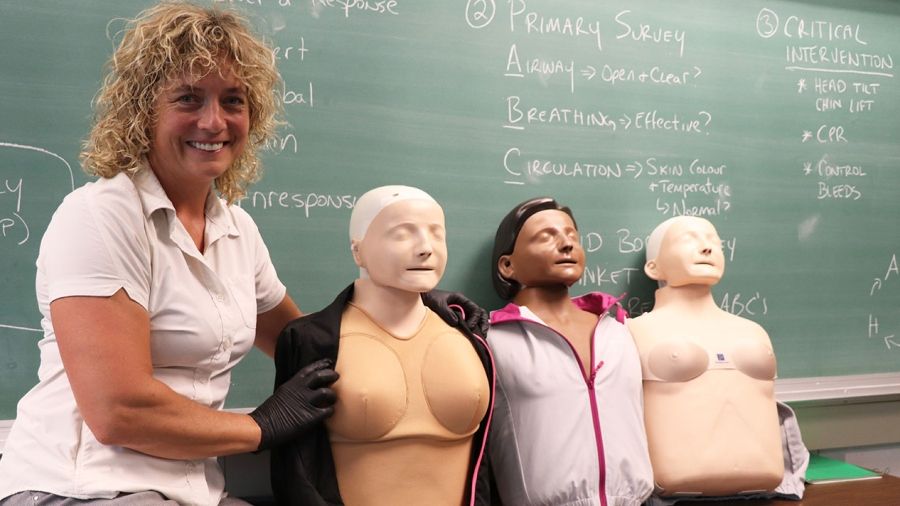
It’s one of the most generous learning pathways you can take for others and a new tool for first aid training at Selkirk College is helping add an important level of comfort when it comes to life-saving measures.
When it comes to cardiac chest pain and distress, studies show that women are less likely to receive proper first aid during time of crisis. Not only do women present differently when it comes to chest pain, but when cardiopulmonary resuscitation (CPR) is required the issue of breasts can provide pause for some who have taken the training. To help combat awkwardness during training, CPR mannequins have been adapted to better reflect the reality.
“The idea is that as you expose the chest to do CPR, since everyone’s chest is different, we want to represent that in our equipment,” explains Wren McElroy, Selkirk College’s Regional Coordinator for Occupational First Aid Training. “This makes people more familiar or more comfortable with doing the appropriate first aid. No matter what your background, body-type, skin colour, shape, size… everybody needs the same level of first aid. If we can provide more diversity with our mannequins, hopefully that will help communicate that message to learners. It’s a start.”
Selkirk College provides a multitude of first aid training options through Community Education & Workplace Training (CEWT). From basic Canadian Red Cross Babysitter Certificate to Occupational First Aid Level 3 to First Aid Instructor Training, the region depends on the college to help keep homes, workplaces and recreational outlets equipped with trained individuals who are prepared to help others in a time of emergency.
Statistics point to women being 27 per cent less likely to receive CPR if they suffer cardiac arrest in public, with researchers highlighting bystanders’ reluctance to touch the chest of a person they don’t know. With this knowledge, the team at CEWT has now customized some training mannequins with breasts for learners to practice on during training. While students focus on the ABC’s (airway, breathing, circulation) of lifesaving, they are also provided a more real-world mannequin to practice on.
“If we can get people more familiar and comfortable in the classroom, they are more comfortable using the life-saving skills in the field,” says McElroy.
A Passion for Life-Saving Training
McElroy grew up in Nelson and is well known in outdoor recreation circles for both her expertise in first aid and her own talents in mountain sport. Her introduction to first aid was at LV Rogers Secondary School when she participated in outdoor recreation with now-retired teacher Howie Ridge.
Taking it a step beyond the basics of ensuring she could help her pals in the backcountry if needed, once McElroy graduated from high school, she began building formalized training that meshed with work experience. She has been employed in industrial construction, with the Ministry of Forests as an initial attack firefighter, as an ambulance attendant, ski patroller and tail guide for catskiing operations. A legendary skier herself, McElroy was the Snow Safety Supervisor at Whitewater Ski Resort until 2018 and is an Avalanche Professional and Industry Training Program Instructor with the Canadian Avalanche Association.
McElroy has been teaching Occupational First Aid courses at Selkirk College since 1997 and in 2016 took over the Regional Coordinator for WorkSafeBC training programs from one of her mentors, Tom VanAlstine. Though she still works contract jobs in a variety of sectors, including her latest stint as an Avalanche Forecaster in Northern B.C. for a mining company, she is passionate about teaching.
“I’m a people-person, so I enjoy the rapport and it’s engaging to share the knowledge,” she says. “I also value that when you teach something, you really have to learn it on a deep level because you have to be able to answer people’s questions. It really makes you learn the material, so when you are applying it in your work or personal life, it’s very deeply ingrained in your head.”
Whether she is training new first aid instructors or jumping into help teach introductory classes, McElroy understands that the concept of helping others in traumatic situations is not for everybody. With her deep experience in real-world emergency situations and an abundance of understanding for how many students feel, McElroy leads the Selkirk College instructional team with an approach that is focused on getting students to embrace the training.
“We try to acknowledge in the introduction to the courses that we understand that some people are not comfortable and it can be intimidating,” she says. “Ultimately, we want people to take what they can from it because it is so applicable to your work or family life. It’s very rewarding to have a positive exchange with students or take people who are not very interested and get them engaged. It’s a skill to do that and a challenge that I really like.”
Back in the first aid classroom on Nelson’s Silver King Campus, McElroy is fresh from teaching an entry level course where the new mannequins were first unveiled to students.
“At this point it’s a bit of an experiment because it’s new and can be a little bit awkward at first, but this acceptance is very important,” she says. “It’s important that people are comfortable with different bodies. Overall in our culture, this is a vital step towards more diversity and body acceptance.”
Learn more about first aid training through Selkirk College and join us on Facebook.
PHOTO CUTLINE: Selkirk College has adapted some of its first aid CPR mannequins to better reflect different body types. Selkirk College’s Regional Coordinator for Occupational First Aid Training Wren McElroy (pictured) calls it step in the right direction for “diversity and body acceptance.”
